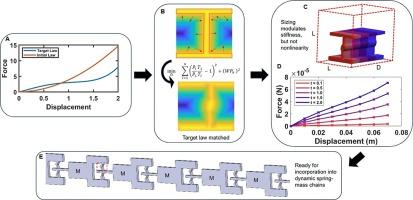Inverse design of two-dimensional architected materials with desired uniaxial polynomial nonlinear constitutive responses aided by stiffness normalization
IF 7.9
2区 材料科学
Q1 MATERIALS SCIENCE, MULTIDISCIPLINARY
引用次数: 0
Abstract
The design of specified nonlinear mechanical responses into a structure or material is a highly sought after capability, with significant potential impacts in areas such as wave tailoring in metamaterials, impact mitigation, soft robotics, and biomedicine. Here, we present a topology optimization approach to design two-dimensional structures for desired uniaxial polynomial nonlinear behavior, wherein we formulate the objective function to match nonlinear coefficient ratios, such that the linear stiffness is decoupled from the desired nonlinearity of the response. We suggest that such linear stiffness decoupling can help aid convergence for problems with fixed, but poorly matched, constituent materials and design volumes. This benefit can be understood by considering, if large absolute force values and stiffnesses are targeted, thicker structures with less open space generally result. Such high volume ratio structures reduce the kinematic freedom (available to, e.g., long thin structures) which is needed for strong geometrically nonlinear responses. We show designs achieved using this approach that match a range of qualitatively different polynomial behaviors with high precision, which are of interest, in particular, within the domain of dynamical systems where nonlinear elasticity of relatively simple polynomial forms can confer greater analytical tractability.

具有期望单轴多项式非线性本构响应的二维结构材料的刚度归一化反设计
将指定的非线性机械响应设计到结构或材料中是一种备受追捧的能力,在超材料的波浪剪裁、冲击缓解、软机器人和生物医学等领域具有重要的潜在影响。在这里,我们提出了一种拓扑优化方法来设计理想的单轴多项式非线性行为的二维结构,其中我们制定了目标函数来匹配非线性系数比,从而使线性刚度与期望的非线性响应解耦。我们建议,这种线性刚度解耦可以帮助解决具有固定但不匹配的组成材料和设计体积的问题。考虑到这一点,可以理解这种好处,如果目标是大的绝对力值和刚度,通常会导致更厚的结构和更少的开放空间。这种高体积比结构降低了运动自由度(可用于,例如,细长结构),这是强烈的几何非线性响应所需要的。我们展示了使用这种方法实现的设计,该方法以高精度匹配一系列定性不同的多项式行为,这是感兴趣的,特别是在动力系统领域,其中相对简单的多项式形式的非线性弹性可以赋予更大的分析可追溯性。
本文章由计算机程序翻译,如有差异,请以英文原文为准。
求助全文
约1分钟内获得全文
求助全文
来源期刊

Materials & Design
Engineering-Mechanical Engineering
CiteScore
14.30
自引率
7.10%
发文量
1028
审稿时长
85 days
期刊介绍:
Materials and Design is a multi-disciplinary journal that publishes original research reports, review articles, and express communications. The journal focuses on studying the structure and properties of inorganic and organic materials, advancements in synthesis, processing, characterization, and testing, the design of materials and engineering systems, and their applications in technology. It aims to bring together various aspects of materials science, engineering, physics, and chemistry.
The journal explores themes ranging from materials to design and aims to reveal the connections between natural and artificial materials, as well as experiment and modeling. Manuscripts submitted to Materials and Design should contain elements of discovery and surprise, as they often contribute new insights into the architecture and function of matter.
 求助内容:
求助内容: 应助结果提醒方式:
应助结果提醒方式:


